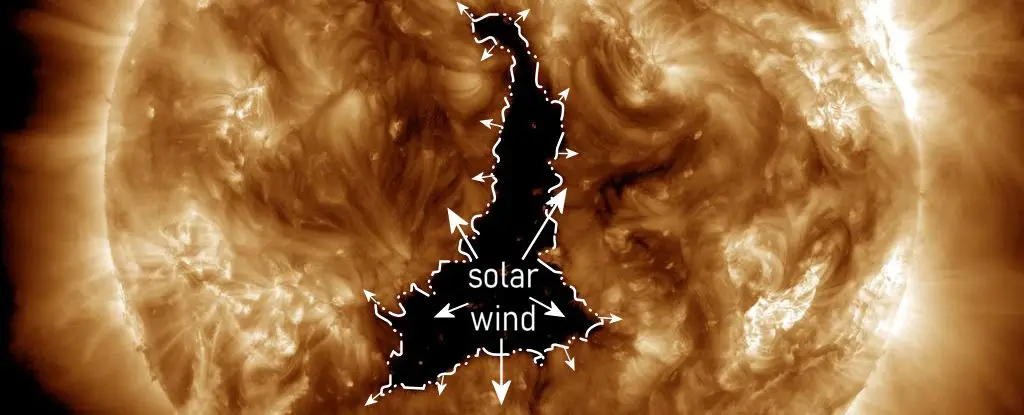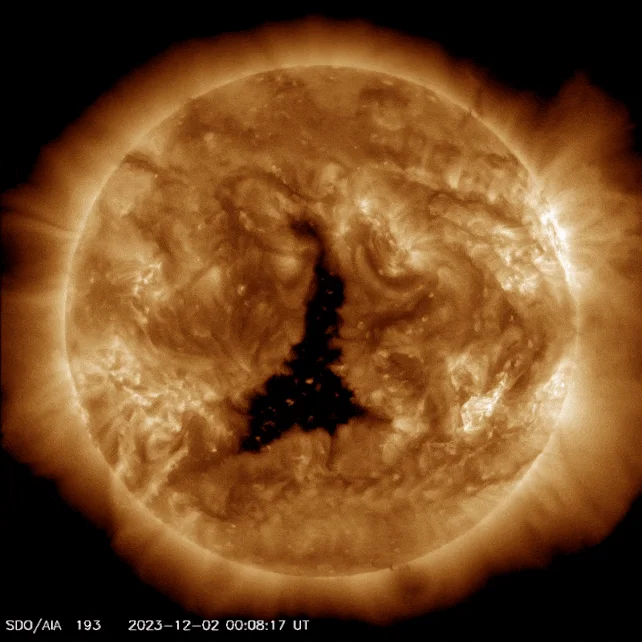Astronomers have recently observed a colossal coronal hole in the Sun’s atmosphere, a phenomenon that has sparked interest and excitement in the scientific community.

This coronal hole, significantly larger than Jupiter, has been releasing a potent solar wind that is traversing the Solar System.
Coronal holes are regions where the Sun’s magnetic field opens up, allowing solar wind, a stream of particles, to escape more freely into space. Unlike sunspots, which are visible in optical light, coronal holes are detectable in ultraviolet wavelengths as vast, dark patches cooler than their surroundings. The recent coronal hole, observed in ultraviolet light on December 2, 2023, has been rotating away from Earth, but it was previously aligned in such a way that it directed a stream of particles towards our planet.

This event resulted in a mild solar storm, part of a broader pattern of increased solar activity as we approach the solar maximum. The solar maximum is the peak of the Sun’s activity cycle, characterized by heightened occurrences of sunspots, solar flares, coronal mass ejections, and coronal holes. This cycle is believed to be driven by the Sun’s magnetic cycles, during which the solar magnetic field reverses polarity, causing the north and south poles to switch places. The next solar maximum is anticipated in 2024.
The Sun’s activity cycles are a natural part of its behavior. Sunspots are temporary spots on the Sun where magnetic fields intensify, resulting in cooler, darker areas. Solar flares and coronal mass ejections are energetic eruptions often associated with sunspots, caused by the snapping and reconnecting of magnetic field lines, releasing immense energy.
The recent coronal hole measured approximately 800,000 kilometers along its longest axis, dwarfing Jupiter’s diameter of around 140,000 kilometers and Earth’s diameter of 12,742 kilometers. When this hole faced Earth around December 2, the ensuing solar wind impacted us over December 4 and 5, causing a G1- to G2-level solar storm. Such storms are the mildest that can affect Earth, with minimal noticeable effects for most people.
During solar storms, particles from the solar wind interact with Earth’s magnetosphere and are channeled along magnetic field lines to the poles, where they create auroral glows. While these enhanced currents can interfere with power grids, satellite operations, radio communications, and navigation systems, the impacts of G1- and G2-level storms are generally minimal.
Coronal mass ejections and flares, more violent than coronal holes, actively eject material outwards, leading to more powerful solar storms. The current solar cycle has been stronger than expected, resulting in spectacular auroral displays at lower latitudes than usual. The NOAA predicts a maximum sunspot number for this cycle of 173, below the average maximum of 179 and significantly lower than the record high of 285 sunspots in March 1958.
As we continue to witness the Sun’s dynamic behavior, the scientific community remains captivated by the potential for more breathtaking auroral activity in the coming months. The study of these solar phenomena not only enhances our understanding of the Sun’s complex processes but also prepares us for potential impacts on Earth’s technological systems.

